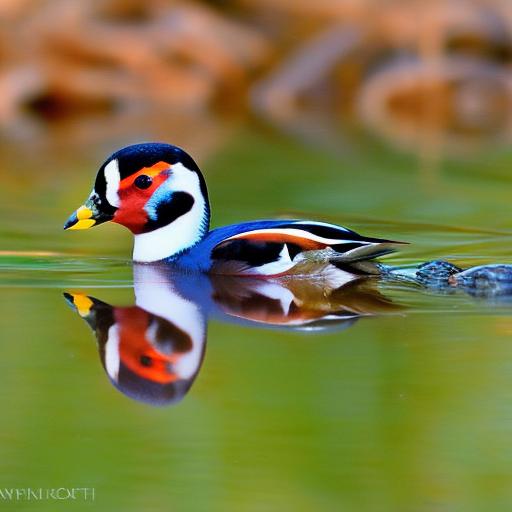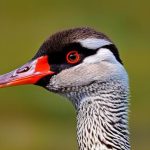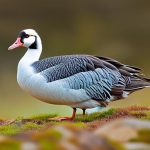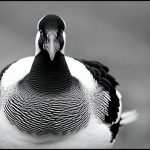African Pygmy Geese, also known as Nettapus auritus, are small waterfowl that belong to the Anatidae family. They are native to sub-Saharan Africa and are known for their unique and interesting characteristics. These geese are fascinating creatures that have captured the attention of bird enthusiasts and researchers alike.
What makes African Pygmy Geese particularly interesting is their small size and striking appearance. They are one of the smallest species of waterfowl in the world, measuring only about 30 centimeters in length. Despite their small size, they have a distinctive appearance with their bright plumage and unique markings. Their coloration varies between males and females, with males having a more vibrant and colorful plumage compared to females.
Key Takeaways
- African Pygmy Geese are small, colorful waterfowl found in sub-Saharan Africa.
- They have distinctive physical characteristics, including a bright blue bill and a white eye-ring.
- African Pygmy Geese prefer to live in wetlands and are found in a variety of habitats across Africa.
- Their diet consists mainly of aquatic plants and invertebrates.
- Breeding behavior includes monogamous pairs and the female laying up to 12 eggs in a nest made of vegetation near water.
Physical Characteristics of African Pygmy Geese
African Pygmy Geese are small birds, measuring around 30 centimeters in length and weighing between 200-300 grams. They have a compact body with short legs and a short, rounded tail. Their wings are relatively short and broad, allowing them to maneuver easily through dense vegetation.
The coloration of African Pygmy Geese is striking, with males displaying a vibrant combination of black, white, and chestnut brown feathers. They have a black head with a white patch on the face, a chestnut brown neck, and a black back with white spots. The underparts of the male are mostly white, with black markings on the breast and flanks.
Females, on the other hand, have a more subdued coloration. They have a brownish-gray head and neck, with a pale gray body and white underparts. The female’s plumage helps them blend into their surroundings and provides camouflage while nesting.
Habitat and Distribution of African Pygmy Geese
African Pygmy Geese are found in various parts of sub-Saharan Africa, including countries such as Kenya, Tanzania, Uganda, and Zambia. They are primarily found in wetland habitats, such as swamps, marshes, and shallow lakes. These geese prefer areas with dense vegetation and floating vegetation mats, which provide them with cover and food sources.
Their distribution is relatively widespread across their range, but they are not considered a common species. They are more localized in their distribution and can be found in specific wetland areas that meet their habitat requirements. The availability of suitable wetland habitats is crucial for the survival of African Pygmy Geese.
Feeding Habits of African Pygmy Geese
African Pygmy Geese are primarily herbivorous and feed on a variety of plant material. They have a specialized diet that consists mainly of aquatic vegetation, such as water lilies, pondweeds, and grasses. They also feed on seeds, fruits, and insects that they find in their wetland habitats.
To obtain their food, African Pygmy Geese feed by dabbling or grazing on the surface of the water. They use their bill to pluck vegetation from the water or to pick seeds and insects from the surface. They are also known to dive underwater to feed on submerged vegetation.
One interesting feeding behavior observed in African Pygmy Geese is their ability to walk on floating vegetation mats. They can navigate through dense vegetation by using their feet to distribute their weight evenly and prevent sinking.
Breeding Behavior of African Pygmy Geese
African Pygmy Geese have unique breeding behaviors that involve elaborate courtship displays and pair bonding. During the breeding season, males engage in courtship displays to attract females. These displays include head bobbing, wing flapping, and vocalizations.
Once a pair bond is formed, the male and female engage in mutual preening and other bonding behaviors. They also establish a territory and defend it from other pairs. The male will often chase away intruders and vocalize to assert his dominance.
The selection of a mate is based on various factors, including physical appearance, behavior, and compatibility. Males with more vibrant plumage and elaborate courtship displays are often preferred by females. The pair bond is typically monogamous, lasting for the duration of the breeding season.
Nesting and Egg Laying of African Pygmy Geese

African Pygmy Geese build their nests in dense vegetation near the water’s edge. They prefer nesting sites that provide cover and protection from predators. The nests are constructed using plant material, such as reeds, grasses, and leaves. The female takes the lead in nest building, while the male assists by bringing materials to the nest.
The female lays a clutch of 4-7 eggs, which are white in color and measure around 30 millimeters in length. The eggs are laid over a period of several days, with one egg being laid each day. Once all the eggs are laid, the female begins incubating them.
Incubation and Hatching of African Pygmy Geese
The incubation period for African Pygmy Geese is approximately 25-30 days. During this time, the female remains on the nest to keep the eggs warm and protect them from predators. The male may assist in incubation by taking turns with the female.
One interesting behavior observed during incubation is the “egg turning” behavior. The female will periodically turn the eggs using her bill to ensure even heat distribution and proper development of the embryos.
When the eggs are ready to hatch, the chicks use their egg tooth to break through the shell. They emerge as small, fluffy balls of down with a yellowish-brown coloration. The chicks are precocial, meaning they are able to walk and feed themselves shortly after hatching.
Raising and Fledging of African Pygmy Geese Chicks
After hatching, the parents provide care and protection to the chicks. They lead them to suitable feeding areas and teach them how to find food. The parents also provide warmth and protection from predators.
The chicks grow rapidly and develop their flight feathers within a few weeks. They fledge, or leave the nest, at around 6-8 weeks of age. Once they are able to fly, the parents continue to provide guidance and protection until the chicks become independent.
During this time, the parents may exhibit interesting behaviors, such as herding the chicks together and vocalizing to keep them in a group. This behavior helps protect the chicks from predators and ensures their safety.
Conservation Status of African Pygmy Geese
African Pygmy Geese are currently listed as a species of least concern on the IUCN Red List of Threatened Species. However, their population is declining due to habitat loss and degradation. Wetland destruction, pollution, and human disturbance are major threats to their survival.
Conservation efforts are underway to protect wetland habitats and raise awareness about the importance of preserving these ecosystems. It is crucial to maintain suitable habitats for African Pygmy Geese to ensure their long-term survival.
Breeding African Pygmy Geese in Captivity: Tips and Guidelines
Breeding African Pygmy Geese in captivity requires careful planning and attention to their specific needs. Before breeding them, it is important to ensure that you have suitable housing facilities that mimic their natural habitat. This includes providing a large enclosure with access to water for swimming and feeding.
To encourage successful breeding, it is important to create a suitable environment that includes nesting sites with dense vegetation for privacy and protection. Providing a balanced diet that includes a variety of plant material, seeds, and insects is also crucial for their reproductive success.
Proper care and monitoring of the birds and their offspring are essential during the breeding process. Regular health checks, providing appropriate veterinary care, and ensuring a stress-free environment are important factors in successful breeding.
In conclusion, African Pygmy Geese are fascinating birds with unique characteristics and behaviors. Their small size, vibrant plumage, and interesting breeding behaviors make them a captivating species to observe. However, their survival is threatened by habitat loss and degradation. Conservation efforts are crucial to protect their habitats and ensure their long-term survival.
If you’re interested in breeding African Pygmy Geese, you may also find this article on poultrywizard.com about the incubation period for goose eggs quite informative. Understanding the incubation process is crucial for successful breeding, and this article provides valuable insights and tips. Check it out here. Additionally, if you’re looking for ideas to create a comfortable and functional chicken coop for your geese, this article on poultrywizard.com offers some fantastic interior design ideas. Discover how to optimize your chicken coop’s layout and make it a perfect home for your feathered friends. Find inspiration here. Lastly, if you’re in search of a reliable chicken coop option, the Producers Pride Sentinel Chicken Coop is worth considering. Learn more about its features and benefits here.
FAQs
What are African Pygmy Geese?
African Pygmy Geese are small waterfowl species that are native to sub-Saharan Africa. They are known for their striking plumage and unique breeding habits.
How do African Pygmy Geese breed?
African Pygmy Geese are cavity nesters, meaning they lay their eggs in tree hollows or other enclosed spaces. They typically breed during the rainy season, which varies depending on their location.
What is the breeding season for African Pygmy Geese?
The breeding season for African Pygmy Geese varies depending on their location. In East Africa, they typically breed from October to December, while in West Africa, they breed from May to August.
How many eggs do African Pygmy Geese lay?
African Pygmy Geese typically lay between 6 and 12 eggs per clutch. The eggs are incubated for around 28 days before hatching.
What do African Pygmy Geese eat?
African Pygmy Geese are omnivores, meaning they eat both plant and animal matter. Their diet includes seeds, insects, crustaceans, and small fish.
Are African Pygmy Geese endangered?
African Pygmy Geese are not currently considered endangered. However, habitat loss and hunting are potential threats to their populations.
Meet Walter, the feathered-friend fanatic of Florida! Nestled in the sunshine state, Walter struts through life with his feathered companions, clucking his way to happiness. With a coop that’s fancier than a five-star hotel, he’s the Don Juan of the chicken world. When he’s not teaching his hens to do the cha-cha, you’ll find him in a heated debate with his prized rooster, Sir Clucks-a-Lot. Walter’s poultry passion is no yolk; he’s the sunny-side-up guy you never knew you needed in your flock of friends!







